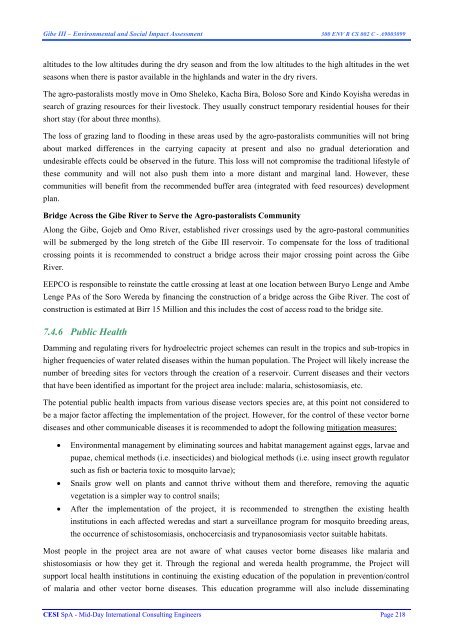Environmental and Social Impact Assessment - Gibe III
Environmental and Social Impact Assessment - Gibe III
Environmental and Social Impact Assessment - Gibe III
Create successful ePaper yourself
Turn your PDF publications into a flip-book with our unique Google optimized e-Paper software.
<strong>Gibe</strong> <strong>III</strong> – <strong>Environmental</strong> <strong>and</strong> <strong>Social</strong> <strong>Impact</strong> <strong>Assessment</strong> 300 ENV R CS 002 C - A9003099<br />
altitudes to the low altitudes during the dry season <strong>and</strong> from the low altitudes to the high altitudes in the wet<br />
seasons when there is pastor available in the highl<strong>and</strong>s <strong>and</strong> water in the dry rivers.<br />
The agro-pastoralists mostly move in Omo Sheleko, Kacha Bira, Boloso Sore <strong>and</strong> Kindo Koyisha weredas in<br />
search of grazing resources for their livestock. They usually construct temporary residential houses for their<br />
short stay (for about three months).<br />
The loss of grazing l<strong>and</strong> to flooding in these areas used by the agro-pastoralists communities will not bring<br />
about marked differences in the carrying capacity at present <strong>and</strong> also no gradual deterioration <strong>and</strong><br />
undesirable effects could be observed in the future. This loss will not compromise the traditional lifestyle of<br />
these community <strong>and</strong> will not also push them into a more distant <strong>and</strong> marginal l<strong>and</strong>. However, these<br />
communities will benefit from the recommended buffer area (integrated with feed resources) development<br />
plan.<br />
Bridge Across the <strong>Gibe</strong> River to Serve the Agro-pastoralists Community<br />
Along the <strong>Gibe</strong>, Gojeb <strong>and</strong> Omo River, established river crossings used by the agro-pastoral communities<br />
will be submerged by the long stretch of the <strong>Gibe</strong> <strong>III</strong> reservoir. To compensate for the loss of traditional<br />
crossing points it is recommended to construct a bridge across their major crossing point across the <strong>Gibe</strong><br />
River.<br />
EEPCO is responsible to reinstate the cattle crossing at least at one location between Buryo Lenge <strong>and</strong> Ambe<br />
Lenge PAs of the Soro Wereda by financing the construction of a bridge across the <strong>Gibe</strong> River. The cost of<br />
construction is estimated at Birr 15 Million <strong>and</strong> this includes the cost of access road to the bridge site.<br />
7.4.6 Public Health<br />
Damming <strong>and</strong> regulating rivers for hydroelectric project schemes can result in the tropics <strong>and</strong> sub-tropics in<br />
higher frequencies of water related diseases within the human population. The Project will likely increase the<br />
number of breeding sites for vectors through the creation of a reservoir. Current diseases <strong>and</strong> their vectors<br />
that have been identified as important for the project area include: malaria, schistosomiasis, etc.<br />
The potential public health impacts from various disease vectors species are, at this point not considered to<br />
be a major factor affecting the implementation of the project. However, for the control of these vector borne<br />
diseases <strong>and</strong> other communicable diseases it is recommended to adopt the following mitigation measures:<br />
• <strong>Environmental</strong> management by eliminating sources <strong>and</strong> habitat management against eggs, larvae <strong>and</strong><br />
pupae, chemical methods (i.e. insecticides) <strong>and</strong> biological methods (i.e. using insect growth regulator<br />
such as fish or bacteria toxic to mosquito larvae);<br />
• Snails grow well on plants <strong>and</strong> cannot thrive without them <strong>and</strong> therefore, removing the aquatic<br />
vegetation is a simpler way to control snails;<br />
• After the implementation of the project, it is recommended to strengthen the existing health<br />
institutions in each affected weredas <strong>and</strong> start a surveillance program for mosquito breeding areas,<br />
the occurrence of schistosomiasis, onchocerciasis <strong>and</strong> trypanosomiasis vector suitable habitats.<br />
Most people in the project area are not aware of what causes vector borne diseases like malaria <strong>and</strong><br />
shistosomiasis or how they get it. Through the regional <strong>and</strong> wereda health programme, the Project will<br />
support local health institutions in continuing the existing education of the population in prevention/control<br />
of malaria <strong>and</strong> other vector borne diseases. This education programme will also include disseminating<br />
CESI SpA - Mid-Day International Consulting Engineers Page 218




